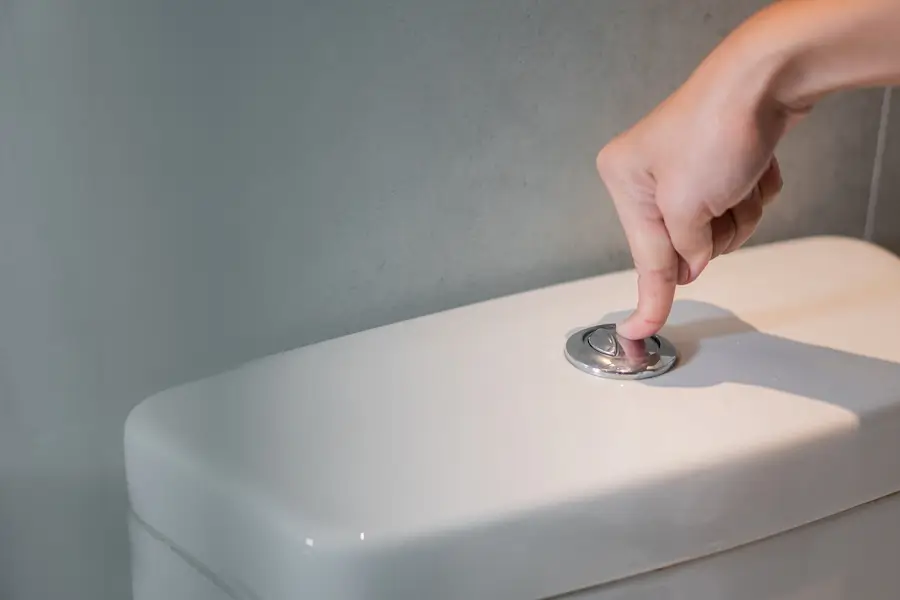
Out of all the appliances and fixtures that need water in our homes, toilets are by far the biggest users. According to the EPA, they account for nearly 30% of indoor water consumption!
Water is a precious resource, which begs the question: How can you adjust your toilet flush volume for water efficiency? Keep reading to learn about the actions you can take.
Understanding Toilet Flush Volumes
Before learning how to make your toilets more water-efficient, it’s helpful to have a basic understanding of toilet flush volumes. Toilet flush volume refers to the amount of water a toilet uses in a single flush, measured in gallons per flush (GPF). The GPF figure takes into account how efficiently it cleans the toilet bowl and clears waste without using more water than necessary.
The GPF rate greatly differs for older toilets compared to modern low-flow and dual-flush toilets. While a modern, high-efficiency toilet uses 1.28 gallons per flush, an older, inefficient toilet uses up to six gallons per flush.
How Much Water Does My Toilet Use?
If you want to know how much water your toilet uses, look for a number printed on the inside of the toilet tank, such as ‘1.6 GPF’ or ‘1.28 GPF.’ If your toilet was manufactured before 1994, it will use more than newer models, which are required to use 1.6 GPF or less.
The most efficient toilets feature a WaterSense label, stating the toilet meets the EPA criteria for using 1.28 GPF or less.
If you have an older-style toilet with high water consumption, now is an ideal time to explore new toilet installation with the help of an experienced plumber. The environmental and financial benefits can be significant!
By replacing old, inefficient toilets with modern, WaterSense-labeled models, you can reduce the amount of water you use for flushing toilets by up to 60%. That’s water savings of 13,000 gallons per year! Replacing an old toilet is also a great way to keep more money in your pocket. You can save $170 per year in water costs or around $3,400 over the lifetime of each toilet.
If we all replaced our inefficient toilets, we could save over 260 billion gallons of water every year, equivalent to the amount of water that flows over Niagara Falls in just under a week!
How Toilets are Designed to Conserve Water
Modern toilets are engineered with a range of features to conserve water while maintaining optimal flushing performance. However, if you don’t believe your modern toilet is as efficient as it could be, or you have an older toilet with fewer features, you may be wondering if it’s possible to conserve even more water. Fortunately, changing the flush volume is possible on multiple toilet types, resulting in additional water savings.
Standard (Gravity-Fed) Toilets
Most common household toilets have multiple flush adjustment options. Start by changing the float height on the fill valve. This will mean the tank holds slightly less water. You can also shorten the flapper chain, making the flapper close sooner, which results in less water being released. Alternatively, replace the flapper with an adjustable version, letting you choose how long the valve stays open.
Some people also invest in displacement devices, like toilet dams, weighted bags, and bottles. These all reduce the tank capacity to reduce water use without affecting the toilet’s performance.
Low-Flow Toilets
Compared to older models that use up to six gallons of water per flush, a low-flow toilet is designed to use from 1.28 to 1.6 GPF. They feature optimized bowl shapes and larger trapways, which help deliver water more precisely to improve the efficiency of each flush with less water.
These models are also reasonably adjustable, with most featuring adjustable floats that allow for lowering the water level in the tank. You can also install a toilet tank displacement device.
Dual-Flush Toilets
Not everything we do in a toilet will require the same volume of water. That’s why dual-flush toilets are common in homes across the country. These toilets offer two flushing options: a half-flush of 0.8 GPF for liquid waste and a full-flush of 1.6 GPF for solid waste. When using the toilet, select the most appropriate flush option to prevent unnecessary water waste.
While dual flush toilets already save water by allowing you to choose a flush type, further water savings are possible with additional adjustments. Some models allow you to adjust the half- and full-flush volumes. It’s also possible to lower the water levels in a dual-flush toilet. This will reduce both flush types proportionally.
If you have one of the latest dual-flush toilets on the market, you may be able to calibrate the water per flush using a dial or similar mechanism.
Pressure-Assisted Toilets
While more common in commercial settings, pressure-assisted toilets are designed for strong performance, reduced water consumption, and a lower risk of clogs. These toilets work by using compressed air inside a sealed tank to push water into the bowl with force. This pressurized system yields a powerful flush, albeit with a reduced water volume.
There are fewer adjustment options available for pressure-assisted toilets. They already aim to use less water by relying on pressure instead of water. However, some systems allow a slight lowering of the water level in the tank. Some models also come with adjustment screws or controls that allow for setting specific flush durations.
Smart or High-Efficiency Toilet
The beauty of investing in a smart or high-efficiency toilet is that it’s already designed for optimal water efficiency. However, most of these toilets have built-in adjustability for user convenience. Some touchless or smart toilet models offer digital programming of flush volumes, while others feature adjustable cartridges that allow users to control the amount of water released with a more manual approach.
Tips for Maintaining Toilet Performance While Reducing Water Use
Reducing water use is crucial for conserving our precious natural resources. However, it shouldn’t be at the expense of an appliance’s performance. If you want to maintain your toilet’s performance while reducing water use simultaneously, here are a few helpful tips:
- Replace the Fill Valve: The fill valve in a toilet, also known as a ballcock or toilet float valve, causes our toilets to waste water when parts like floats and seals break down. When this happens, the toilet tank fill valve can stop closing entirely, resulting in leaks in both the toilet tank and bowl.
- Install an Adjustable Flapper: The flapper valve controls how much water enters the toilet bowl with each flush. A leaky or inefficient flapper can cause your toilet to use excess water or run continuously. Replacing it with an adjustable flapper lets you control the flush volume, conserving water by setting how long the flapper stays open.
- Don’t Overload the Bowl: The more toilet paper you put into your toilet, the more likely it is that your toilet will produce a weak flush, necessitating the need for a double flush. Use only as much toilet paper as necessary to minimize water usage.
- Clean and Maintain Your Toilet: Cleaning and maintaining a toilet involves more than just scrubbing the bowl. To ensure it remains functional and doesn’t use excess water, you also need to maintain flappers, valves, seals, and other parts. Mineral deposits, grime, and worn parts all contribute to reduced flush efficiency. Inspect your toilet regularly to ensure all parts are in working order and replace worn components as required.
Contact Mr. Rooter Plumbing® for Expert Toilet and Plumbing Services
Water is a precious resource that we should conserve as much as we can. If you don’t think your toilet is operating as efficiently as it could be, you want to learn how to adjust the water level in your toilet bowl, or have another toilet-related question, reach out to your locally owned and operated Mr. Rooter Plumbing® for help. We can address problematic fill valves, adjust toilet floats, and even replace old toilets that have reached the end of their service lives. Call us today or request a job estimate online.

